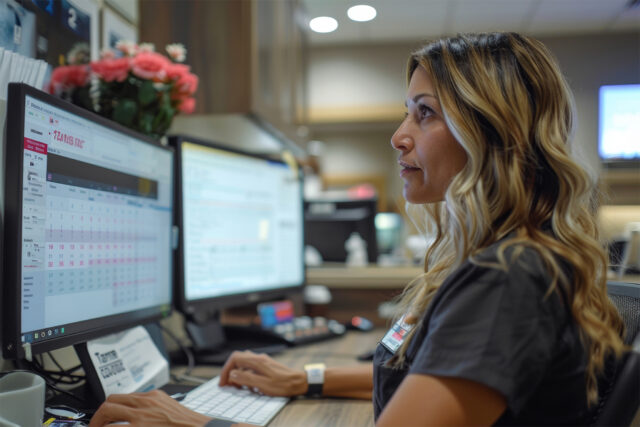Have you ever wondered what the national average no-show rate is for your specialty? Or what your no-show rate is in comparison? If so, this post is for you. Patient no-show rates can range anywhere from 5%–30% or more. Here are the averages for some of the most common healthcare specialties as discovered by multiple studies:
- Dentistry: 15%
- Optometry: 25%
- Primary Care: 19%
- OB/GYN: 18%
- Pediatrics: 30%
- Dermatology: 30%
- Ophthalmology: 22%
- Neurology: 26%
- Oncology: 25%
- Endocrinology: 14%
- Sleep clinics: 39%
These no-shows can lead to incredible losses for your practice. The average value of a single visit for these specialties ranges from $125 to $350. The lost revenue can end up being in the thousands or tens of thousands every month, especially if the patient was not rescheduled.
See 10 Ways You Can Reduce No-Shows
What is your average no-show rate compared to the national average no-show rate?
To benchmark what your no-show rate is, you’re going to have to dust off your old math book. Look at your last month (and then go back even further to get a good average for the year). How many appointments were scheduled? Write that number down. How many patients did not show up for their appointment time? Write that down.
Now, your no-show rate will be the number of missed appointments divided by the total number of scheduled appointments. You will then multiply that number by 100.
Average no-show rate calculation
Let’s say that last month you scheduled 400 appointments, and only 300 patients showed up (so you had 100 no-shows).
So … 100/400 is 0.25.
You then multiply 0.25 by 100 to get your total no-show rate.
0.25 x 100 = 25% no-show rate
How does that number compare to the national average no-show rate for your specialty? Are you higher than the average? Or are you doing well? Making even small improvements to your no-show rate can have a big impact on your bottom line.
See How One Practice Reduce No-Show Rates by 50% (CASE STUDY)
Reasons patients don’t show up for their appointments
While every situation is unique, there are a few common themes we hear from patients about why they don’t show up for their appointments. Here are a few of those (and what you can do about it):
- They forget. We’re crazy busy these days. Many patients are literally running from place to place. It’s easy to forget things you’ve scheduled, especially if that thing was scheduled far in advance. This is one of the BEST reasons for your practice because you can find ways to help. Forgetfulness is where your patient appointment reminders and appointment confirmations come in really handy. Studies show that patients who receive appointment reminders are far more likely to show up than those who do not.
- They don’t have the money. Let’s face it. Healthcare can be expensive! Try to come up with creative ways to make the payment side easier for patients, and you will find that many more are showing up for their appointments. A couple of ideas that are very successful include offering healthcare credit such as Care Credit or letting patients pay through payment plans.
- They’re afraid. Who likes getting poked and prodded all the time? The compassion you show patients and the overall atmosphere can make a big difference to patient satisfaction rates when they are feeling a little nervous about visiting you.
- Last-minute conflicts. There will be times when you just can’t get away from it. Emergencies and other conflicts are inevitable. Make it easy for patients to let you know about these issues. Text messages are one of the best ways. And then, once they’ve canceled, use a wait-list system to get that appointment slot filled ASAP.
Read more blogs about no-show rates and appointment reminders:
No-Show Policies that Won’t Scare Off Patients
10 Truly Awesome Ways to Reduce No-Shows
Patient communication tools can help build efficiency in your practice and help your front-line staff to reduce the number of no-show appointments. Contact Solutionreach today to learn about our suite of tools to help your admin staff avoid burnout while helping your practice to be more profitable while still providing high-quality care.



